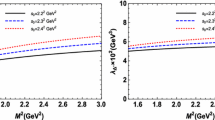Summary
Radial excitation modes are analyzed for nonstrange baryons. It is found that the baryon radial mode exhibits a harmonicoscillatorlike mass spectrum with the energy spacing of 270 MeV. It is shown that a largeSU 6 force is responsible for this narrow spacing. It is shown also that thisSU 6 force is responsible for the exceptionally low mass of the Roper resonance.
Riassunto
Si analizzano i modi di eccitazione radiali per barioni non strani. Si trova che il modo radiale del barione presenta un spettro di massa del tipo dell’oscillatore armonico con intervallo di energia di 270 MeV. Si dimostra che una grande forza diSU 6 è responsabile di questo piccolo intervallo. Si dimostra anche che questa forza diSU 6 è responsabile della massa eccezionalmente bassa della risonanza di Roper.
Реэюме
Проводится аналиэ мод радиальных воэбуждений для нестранных барионов. Получается, что барионная радиальная мода обнаруживает массовый спектр, аналогичный спектру гармонического осциллятора, с интервалом 270 МзВ. Покаэывается, что больщаяSU 6 сила является ответственной эа зтот уэкий интервал. Также отмечается, что зтаSU 6 сила ответственна эа зкспоненциально инэкую массу реэонанса Ропера.
Similar content being viewed by others
References
O. W. Greenberg:Phys. Rev. Lett.,13, 598 (1964).
M. Gell-Mann:Phys. Lett.,8, 214 (1964);G. Zweig: CERN Report No. TH 401 and TH 412 (1964) (unpublished). For review articles, seeR. H. Dalitz: inProceedings of International Conference on Symmetries and Quarks Models (Detroit, Mich., 1969);O. W. Greenberg: inProceedings of the Lund International Conference on Elementary Particles (Lund, 1969);S. Meshkov:Review of hadron spectroscopy, invited talk presented atInternational Conference on Daulity and Symmetry in Hadron Physics, Tel-Aviv, April 1971.
The harmonic oscillator is the starting point for some of dual-resonance models. See, for instance,L. Susskind:Phys. Rev. Lett.,23, 545 (1969);Y. Nambu: inProceedings of International Conference on Symmetries and Quark Models (Detroit, Mich., 1969).
For a review of earlier mass formulae, seeA. Pais:Rev. Mod. Phys.,38, 215 (1966) and the references contained therein.
O. W. Greenberg andM. Resnikoff:Phys. Rev.,163, 1844 (1967);D. R. Divgi andO. W. Greenberg:Phys. Rev.,175, 2024 (1968).
Some more recent work based on the harmonic-oscillator model is contained inR. P. Feynman, S. Pakvasa andS. F. Tuan:Phys. Rev. D,2, 1267 (1970);C. A. Heusch andF. Ravndal:Phys. Rev. Lett.,25, 253 (1970).
K. Fujimura, T. Kobayashi andM. Namiki:Progr. Theor. Phys.,44, 193 (1970).
R. P. Feynman, M. Kislinger andF. Ravndal:Phys. Rev. D,3, 2706 (1971).
J. A. Shapiro:Ann. of Phys.,43, 439 (1968);G. Karl andE. Obryk:Nucl. Phys.,8 B, 609 (1968).
C. T. Chen-Tsai andS. I. Chu:Level structure of baryons and quark-quark interaction (to be published);C. T. Chen-Tsai andT. Y. Lee:SU 6 assignment of the positiveparity nucleonic resonances (to be published).
This formula resembles the mass formula ofGreenberg et al. (4). All terms, exceptM 6, can be found in their mass formula. Since they do not consider then=2 level, ourM 6-term is essentially contained in theirC 2 /(6)-term which tells the difference between [56] withL=0 and [70] withL=1. We thankO. W. Greenberg for an illuminating discussion on this point.
We thankS. Meshkov for stressing the importance of this point.
S. Almehed andC. Lovelace: preprint (November 1971). We thankP. Steinberg for bringing this paper to our attention.
Our mass formula for then=0 multiplets is very similar to the one originally considered byYa. B. Zel’dovich andA. D. Sakharov. SeeE. M. Levin andL. L. Frankfurt:Usp. Fiz. Nauk,92, 243 (1968) (English translation:Sov. Phys. Uspekhi,11, 106 (1968)).
For boundary conditions for bound states and resonances, seeY. S. Kim andK. V. Vasavada:Phys. Rev. D,5, 1002 (1972).
Author information
Authors and Affiliations
Additional information
Supported in part by the National Science Foundation under Grant Number NSF GP 8748.
Rights and permissions
About this article
Cite this article
Kim, Y.S., Noz, M.E. Radial excitations in the symmetric quark model. Nuov Cim A 11, 513–522 (1972). https://doi.org/10.1007/BF02729460
Received:
Published:
Issue Date:
DOI: https://doi.org/10.1007/BF02729460




